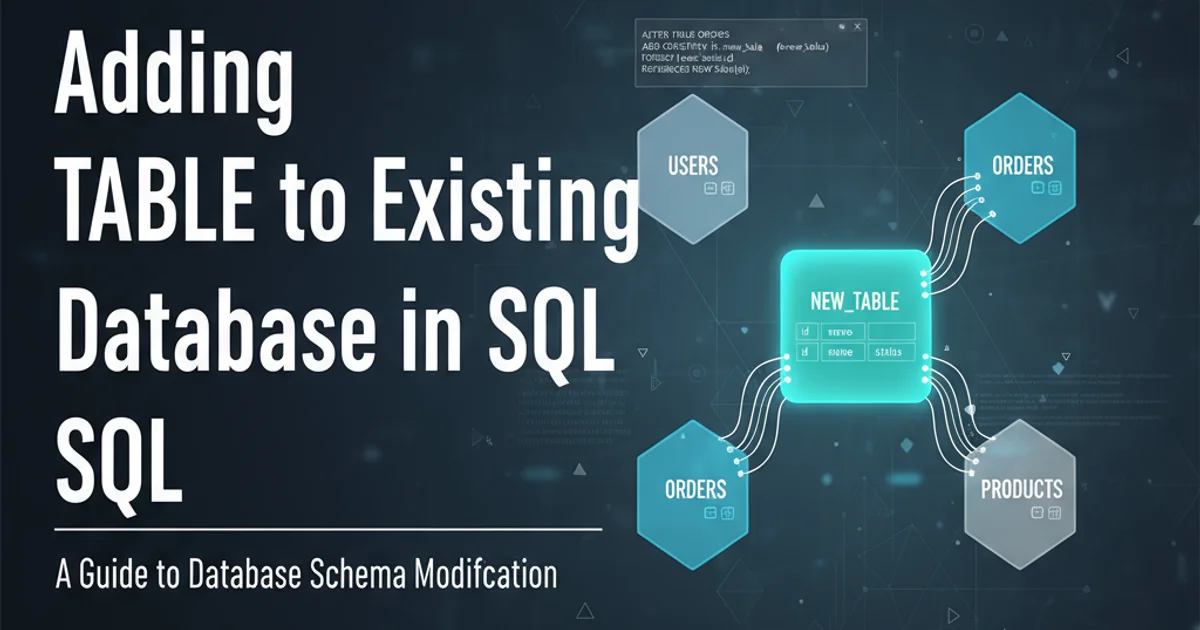Adding table to existing database in SQL
Adding a New Table to an Existing SQL Database

Learn the fundamental SQL commands and best practices for safely and efficiently adding new tables to your database schema, covering various SQL dialects.
Adding a new table is a common operation in database management, essential for extending your data model to accommodate new features or information. This article will guide you through the process of creating a new table in an existing SQL database, covering the basic CREATE TABLE statement, defining columns, specifying data types, and setting up constraints. We'll also touch upon considerations for different SQL dialects like SQL Server and PostgreSQL.
Understanding the CREATE TABLE Statement
The CREATE TABLE statement is the primary command used to define a new table in a SQL database. It requires you to specify the table's name, followed by a list of column definitions. Each column definition includes the column's name, its data type, and any constraints that apply to it. Constraints are rules enforced on data columns to limit the type of data that can be inserted into a table, ensuring data integrity.
CREATE TABLE NewCustomers (
CustomerID INT PRIMARY KEY IDENTITY(1,1),
FirstName VARCHAR(50) NOT NULL,
LastName VARCHAR(50) NOT NULL,
Email VARCHAR(100) UNIQUE,
PhoneNumber VARCHAR(20),
DateAdded DATETIME DEFAULT GETDATE()
);
Basic CREATE TABLE statement for a 'NewCustomers' table in SQL Server.
erDiagram
CUSTOMER ||--o{ ORDER : places
CUSTOMER {
int CustomerID PK
varchar FirstName
varchar LastName
varchar Email
varchar PhoneNumber
datetime DateAdded
}
ORDER {
int OrderID PK
int CustomerID FK
date OrderDate
decimal TotalAmount
}Entity-Relationship Diagram showing the 'NewCustomers' table and its potential relationship with an 'Order' table.
Key Components of a Table Definition
When defining a table, several key components ensure its structure is robust and meets your data storage needs:
- Column Names: Descriptive names for each piece of data.
- Data Types: Specify the type of data each column will hold (e.g.,
INT,VARCHAR,DATETIME,BOOLEAN). Choosing the correct data type is crucial for performance and data integrity. - Constraints: Rules that enforce data integrity. Common constraints include:
PRIMARY KEY: Uniquely identifies each row in a table. A table can have only one primary key.FOREIGN KEY: Establishes a link between two tables, enforcing referential integrity.NOT NULL: Ensures that a column cannot have aNULLvalue.UNIQUE: Ensures all values in a column are different.DEFAULT: Provides a default value for a column when no value is specified.CHECK: Ensures that all values in a column satisfy a specific condition.
Adding a Table with a Foreign Key Relationship
Often, new tables need to relate to existing tables. This is achieved using a FOREIGN KEY constraint, which links a column (or combination of columns) in one table to a PRIMARY KEY in another table. This ensures referential integrity, meaning you cannot have an order for a customer that doesn't exist.
CREATE TABLE Orders (
OrderID INT PRIMARY KEY IDENTITY(1,1),
CustomerID INT NOT NULL,
OrderDate DATE NOT NULL DEFAULT GETDATE(),
TotalAmount DECIMAL(10, 2) NOT NULL,
CONSTRAINT FK_CustomerOrder FOREIGN KEY (CustomerID) REFERENCES NewCustomers(CustomerID)
);
Creating an 'Orders' table with a foreign key linking to the 'NewCustomers' table.
1. Plan Your Table Structure
Before writing any SQL, define the purpose of the new table, the data it will store, and its relationships with existing tables. Identify necessary columns, their data types, and required constraints.
2. Draft the CREATE TABLE Statement
Write the CREATE TABLE statement, including column definitions, primary keys, and any NOT NULL, UNIQUE, or DEFAULT constraints. If applicable, define foreign key relationships.
3. Test in a Development Environment
Always execute your CREATE TABLE script in a development or staging environment first. This allows you to catch syntax errors, constraint violations, or unexpected behavior without affecting your production data.
4. Execute on Production (with caution)
Once thoroughly tested, execute the CREATE TABLE statement on your production database. It's advisable to perform a backup before making schema changes to production systems.
5. Verify Table Creation
After execution, verify that the table has been created correctly by checking the database schema or running a simple SELECT * FROM YourNewTable; query (which will return an empty set if no data has been inserted yet).